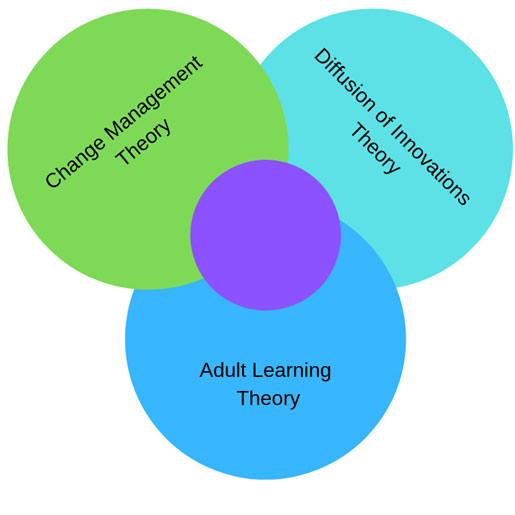“Perfect,” you think, as you watch the vendor demonstrate the application that you just know is going to make a huge positive change in your organization. “This is truly the one!” You contract the system, spend months implementing and customizing it to fit the needs of both your users and your management team, and you launch it with great fanfare…and then no one adopts it.
Launching a new technology, a new version, or a change to the way you use a technology is challenging and can be scary. It’s even harder when many or most of your team works remotely, so you can’t just walk around and informally watch how they’re using it or get feedback on the system and how it fits into a workday. But there are three academic theories that you can apply to your technology to make sure it truly gets adopted.

Lewin’s Theory of Change (1947) is predicated on three primary steps, Unfreeze —> Change —> Refreeze. In this approach, change can be managed by treating the organization as a shape in solid ice that can be reduced to water and then reshaped. This theory has been understood to be a classical and seminal work that is the basis for many contemporary theories (Schein, 1996; Dent and Goldberg, 1999). For example, Kotter’s Process for Change (1996) took the basic three-step approach identified by Lewin (1947) and added “a set of prescriptive steps to work through the mechanism of understanding the resistance to change” (Grant, 2016, p. 38) which provides for and applies additional steps to Lewin’s seminal theory. Kotter’s eight-step process mirrors the Lewin Theory of Change (1947) but is more flexible and allows for a less linear approach, which benefits an organization that is undertaking more than one change management process at a time, even if they are in varying stages of change (Eshleman, 2015, p. 41). Additionally, Lewin’s Theory of Change (1947) has been evaluated against job-related knowledge transfer, quality improvement initiatives, and process change implementation in organizations (Callahan, 2015, p.8). Unfreezing, the first step in Lewin’s change model (1947), has been pointed to as the step that defines modern quality improvement philosophy and practice (Burnes, 2007, p. 227).
In the Knowles Adult Learning Theory (1968), the concept of andragogy, how adults learn, was distinguished from pedagogy, how children learn. In pedagogy, the learner does not know what he needs to learn, and in andragogy, the adult learner takes an active role in the learning. This theory is applied to any situation where an adult needs to learn a new topic or skill, and is viewed as a seminal work for adult learning. The adult learner in a work setting, being trained as a human resource, has been evaluated using the basic Knowles Adult Learning Theory (1968) with a social capital theory spin by Kessels and Poell (2004). These authors expand the definition of learning environment to include the knowledge sharing and hands-on learning that is experienced in the workplace. Additionally, social constructivists have expanded the Knowles Adult Learning Theory (1968) to include an emphasis on andragogy: “(a) learning as a process of active engagement; (b) learning as an individual experience as well as a social phenomenon; and (c) learner differences as useful resources” (Wilson & Peterson, 2006, p. 1).
Rogers, in the Diffusion of Innovations Theory (1962), explains how innovations take hold in a specific field or population, whether that innovation is an idea, object, or process or behavior. Rogers defines diffusion as “the process in which an innovation is communicated through certain channels over time among the members of a social system” (Rogers, 2003, p. 5). Rogers outlines five key stages in technology adoption: innovators, early adopters, early majority, late majority, and laggards. Researchers have evaluated the seminal Diffusion of Innovations Theory in combination with other theories, such as the Technology Acceptance Model (Davis, Bagozzi, & Warshaw, 1989) in order to evaluate how innovations are accepted and adopted and by whom in organizations and specific industries (Boakye, McGinnis, & Prybutok, 2014). Modern studies on adoption and the diffusion of innovations theory have correlated workforce issues and delays and expensive failures to the lack of adoption in healthcare (Myers, 2010).
As you roll out your new technology, consider these three user adoption theories and how you can work them into your launch plan. Managing the change, understanding how adults learn, and ensuring your innovation gets spread across the organization will allow you to ensure greater success with technology adoption. When you are constructing your launch plan, outline and identify how you will cover these three key areas to make sure that your stakeholders are an integral part of your go-live rollout.













